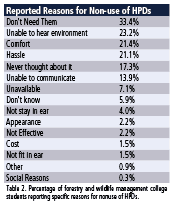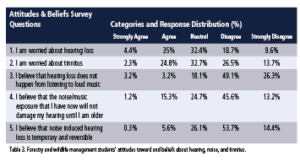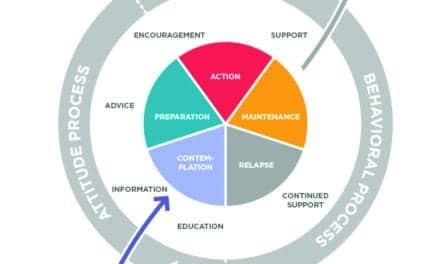Research/Hearing Conservation | May 2014 Hearing Review
Fields that threaten hearing acuity may benefit from hearing education initiatives
By Ashleigh J. Callahan, PhD; Norman J. Lass, PhD; Allison R. Martinelli; and Rachel Bell
Noise exposure has many known harmful effects on health and hearing. Noise-induced hearing loss (NIHL), tinnitus (ringing or buzzing in the ears), hyperacusis (loudness intolerance), diplacusis (difficulty in pitch perception), and other changes in auditory function can be caused from high-intensity sound exposure during occupational or recreational activities. Those at highest risk for occupational NIHL are employed in settings such as heavy industry, factories, coal and ore mining, mechanical engineering, and construction.1
The Occupational Safety and Health Administration (OSHA)2 and the National Institute for Occupational Safety and Health (NIOSH)3 regulate permissible noise exposure levels for workers in order to reduce these harmful effects. OSHA implements a permissible noise exposure level for workers of 90 dBA for 8 hours with a 5 dB exchange rate, while NIOSH enforces similar yet more stringent criteria of 85 dBA for 8 hours with a 3 dB exchange rate.2,3
Forestry workers may have noise exposure originating from the use of heavy equipment, power saws, and other devices. A NIOSH time-weighted average (TWA) of 90.2 ±5.1 dBA (with the highest exposure levels originating from unbelling chokers on landings and chain saws) has been documented in forestry workers.4 Particularly those forest workers with vibration-induced white finger, a condition caused by operating vibrating machinery, and those with advancing age may be more vulnerable to NIHL.5,6
Forestry and wildlife management students participate in hunting, target shooting, agriculture, and other practices with potentially harmful noise levels that entail greater noise exposure than other disciplines. For those students who use firearms, depending on the barrel size and rounds being fired, exposure can range from 140 to 174 dBA.7 Additionally, for those operating chain saws, hearing loss is a potential concern given noise levels of 90-105 dBA.8 Agricultural practices, such as heavy machinery use, also may create potentially damaging levels of noise.9 Chain saws, combines, grinders, choppers, grain dryers, and tractors are potential sources of noise exposure for agriculturists. For example, noise levels of combines without an insulating cab can range from 85 to 90 dBA.10 For many of these activities, the use of hearing protection devices (HPDs) may be the only means to prevent NIHL.
Additional activities that may contribute to NIHL in students with interests in forestry and wildlife may include woodworking, mowing lawns, and/or attending National Association for Stock Car Auto Racing (NASCAR) races. Machinery commonly used in recreational woodworking can produce noise levels from 85 to 114 dBA.11 Noise levels of typical gas-powered lawn mowers range from 85 to 90 dBA at the operator’s ear,12 while grass trimmers (ie, string trimmers or weed eaters) can peak at 105 dBA.13 Moreover, in activities such as NASCAR events, spectators, workers, and drivers are exposed to sounds reaching 109 dBA.14
Current studies support the fact that many young adults exhibit a lack of concern regarding potential risks to the auditory system.15-17 In a survey of college students, the majority of respondents reported awareness of noise exposure and associated hearing loss; however, half of the surveyed students reported potentially harmful exposure to loud music.16 Following noise exposure, college students may experience warning signs of auditory damage, including changes in hearing acuity, as well as tinnitus and/or ear pain. For example, a recent study of college students revealed that 64% experience temporary threshold shifts, 73% have perceived tinnitus, and 69% indicate having ear pain after noise exposure.15 Of the students surveyed, few admitted using HPDs for most recreational activities, with the exception of using firearms, in which the majority (65%) did use hearing protection.
College students also may have music exposure from attending concerts, using portable listening devices (PLDs), and frequenting establishments such as bars and nightclubs. In an interdisciplinary long-term study examining the effects of recreational noise exposure, equivalent sound levels ranging from 104.3 to 112.4 dBA were measured in discos and from 75 to 105 dBA from PLDs.18 In a systematic critical review of PLDs studies—although the consensus does not provide a direct relationship between PLD use and hearing loss—teens and young adults may have an increased risk for NIHL depending on the intensity and duration of PLD usage throughout the lifespan.19
The primary purpose of the present study was to examine noise exposure and hearing health choices of students taking forestry and wildlife management courses. This study also examined student participation in different types of activities with potentially hazardous noise levels, the frequency of HPD use for these activities, their perception of changes in hearing following these activities, and their reasoning behind HPD nonuse. This population of students was chosen due to their potential risk of noise exposure specific to their occupational training and recreational activities. Once graduated, these college students will likely be working in the forestry and wildlife management fields.
Method
During a fall semester at West Virginia University (WVU), noise exposure and perceptions of hearing health were assessed through a survey of 344 college students in forestry (FOR) and wildlife management (WMAN) courses. Surveyed courses included Natural Resources (FOR 140); Elements of Silviculture (FOR 320); Introduction to Wildlife and Fisheries (WMAN 175); Vertebrate Natural History (WMAN 224); Renewable Resources: Policy/Government (WMAN 421); and The Tradition of Hunting (WMAN 100).
Participants were asked to complete a researcher-generated questionnaire containing questions related to listening habits, self-perceptions, knowledge, attitudes, and beliefs about hearing loss, hearing health, noise exposure, and hearing conservation (see Appendix A). In addition to demographic information, including age, gender, height, weight, race, college rank, and socioeconomic status (estimated by parent education and household income), students were surveyed about exposure to potentially hazardous recreational noise (eg, iPod/MP3 player use, concert attendance, target shooting) to which they are exposed. Students were asked whether they perceive changes in hearing after participating in the activity and whether they wore HPDs during the activity, as well as the frequency of HPD use in these specific situations.
In addition, students were asked about self-perceptions of hearing loss and tinnitus, as well as their education regarding the importance of hearing health, hearing preservation, importance of wearing hearing protection in potentially hazardous levels of noise, and, if applicable, when the education occurred. All procedures are on file with the WVU Institutional Review Board for the Protection of Human Subjects (IRB).
Results


Participants also were categorized by the World Health Organization (WHO) Body Mass Index (BMI) classification system using the reported weight divided by the square of the reported height (kg/m2).20 The students’ reported height and weight measurements were converted from pounds to kilograms and feet to meters for use in the calculation. The BMI classification was used to view body mass as a factor relating to hearing health habits. The categories were as follows: “underweight” (<18.50); “normal range” (18.50-24.99); “overweight” (?25.00-29.99); and “obese” (?30.00).20 The majority of respondents (58.4%) were within the “normal” BMI range. Only 3.2% were considered “underweight,” while 23.8% were “overweight,” and 14.5% were “obese.”
Parent education level and parental household income were factors used to provide an indication of the students’ socio-economic status. Respondents indicated the highest education of either parent as follows: 0.6% receiving less than a high school diploma; 26.2% receiving a high school diploma; 7.3% obtaining an associate degree; 13.4% completing some college; 28.5% graduating college with a bachelor’s degree; 19.3% graduating college with a master’s degree; and 4.4% completing a doctoral degree. The household income of students’ parents was 8.5% earning $25,000 or less, 20.3% earning $26,000 to $50,000, 25.8% earning $51,000 to $75,000, 27.0% earning $76,000 to $100,000, and 17.9% earning above $100,000.
Recreational activities with potential noise exposure. Of the 15 surveyed recreational activities (Figure 1), the most frequently reported were mowing lawns (88.6%), frequenting restaurants or bars with loud music (87.1%), and using an iPod/MP3 player (83.7%). Many students also reported target shooting (69.3%), ATV/4-wheeler/motorcycle riding (67.8%), hunting (64.5%), as well as other activities such as use of chain saws (58.9%), farm equipment (50.8%), and machinery (48.5%). Examples of less frequently reported activities include working in the mining industry (1.8%), playing in a band (9.8%), and attending NASCAR events (16.1%).
The use of HPDs (Figure 2) was most common during target shooting (70.0%), when using a chain saw (47.1%), and when engaging in machinery use (34.4%). Students reported that they were least likely to wear HPDs while frequenting restaurants or bars with loud music (1.6%) and attending concerts (3.7%).

Figure 3. Students’ noticed decrease in hearing after participating in “noisy” recreational activities.
Students’ self-perception of their hearing status was addressed by asking students if they had noticed a change (decrease) in their hearing after participating in any of the 15 activities. The most frequent activity in which a change was reported was after attending concerts (61.8%), as shown in Figure 3. One fourth of students (25.1%) noticed a change in hearing after hunting and machinery use, while the activities with the lowest frequency of students noticing a change in hearing were mining (3.3%), woodworking (9.7%), and frequenting restaurants or bars with loud music (13.0%).
Attitudes toward hearing protection. The most frequently reported reason for HPD nonuse (Table 2) was that students felt that HPDs were “not needed” (33.4%). Additional reasons for nonuse of HPDs included: unable to hear environmental sounds (23.2%), comfort (21.4%), and hassle (21.1%). Of those students who did report wearing HPDs, the most common devices were foam plugs/flange plugs (51.6%) and earmuffs (25.2%), as displayed in Figure 4.


Figure 5. Forestry and wildlife management students’ responses to the statement “I have difficulty hearing.”
The majority (62.1%) either disagreed (37.5%) or strongly disagreed (24.6%) with the statement “I have difficulty hearing,” while only 1.2% strongly agreed (Figure 5). Only 15.3% stated that they have a documented hearing loss, with listed causes including noise exposure (45.1%), “ear infections” (17.6%), unknown (11.8%), military service (9.8%), multiple causes (5.9%), heredity (3.9%), tympanic membrane perforations (3.9%), and “cauliflower ear” (2.0%). Of those 15.3% indicating documented hearing loss, responses included 42.3% unilateral, 32.7% bilateral, and 25.0% undescribed hearing loss; 28.8% reported hearing loss in low frequencies, 9.6% in high frequencies, and 61.5% left their hearing loss undescribed.
While the overwhelming majority (94.8%) of respondents stated that they “never” (44.9%) or “occasionally” (49.9%) experience tinnitus (“ringing or buzzing in the ears”), few stated that they “frequently” (3.2%) or “always” (2.0%) perceive tinnitus (Figure 6). The majority (58.1%) of respondents disagreed (35.2%) or strongly disagreed (22.9%) that their PLDs are listened to at a volume loud enough for others to hear (Figure 7).

Figure 7. Forestry and wildlife management students’ responses to the statement “When you are listening to your iPod or MP3 player headphones, other people can hear the music.
Attitudes toward and beliefs about hearing and tinnitus. Students’ attitudes toward hearing loss, tinnitus, and noise exposure were examined (Table 3) with more than one-third (39.4%) of students agreeing (35.0%) or strongly agreeing (4.4%) with the statement “I am worried about hearing loss,” while only one-quarter (24.8%) agreed or strongly agreed (2.3%) with the statement “I am worried about tinnitus (ringing or buzzing in the ears).” Additional responses to the statements “hearing loss does not happen from listening to loud music; noise/music exposure that I have now will not damage my hearing until I am older; and noise induced hearing loss is temporary and reversible” also are included in Table 3.

Figure 8. Forestry and wildlife management students’ previous education in hearing health, hearing preservation, and importance of wearing HPDs.
Previous hearing health education. Education about hearing health, hearing preservation, and importance of wearing HPDs in potentially hazardous levels of noise also were addressed, with the majority (76.0%) of respondents reporting some previous education. The most common forum for previous education was during high school (48.4%), junior high school/middle school (42.6%), and/or elementary school (41.1%). Very few reported education in other settings, including job training (6.2%), the military (4.3%), college (1.6%), and the media (1.2%) (Figure 8).
Discussion
Most forestry and wildlife management students in this study are young adult male Caucasians with normal BMI. Over half of the students report being raised by college-educated caregivers in households with reported incomes of more than $51,000. Although the findings cannot be generalized to all young adults, the data can provide insight into the attitudes and behaviors of many college students in the United States.
The majority of students reported participation in activities with potential exposure to excessive noise levels, such as lawn mowing, target shooting, ATV/motorcycle riding, and hunting, while over half also report using chain saws and farm equipment. Most students reported PLD use, with nearly 20% agreeing that other people can hear the music when they are listening through their PLD headphones. Additional activities with potential music exposure (concert attendance and restaurant/bar noise) also were frequently reported, which may increase their risk for NIHL. The majority of students did report the perception of decreased hearing after concert attendance, but not for other activities in which they participate.
In instances where potentially hazardous noise levels are likely to be reached, the majority of students indicated that they did not wear hearing protection. The exception is target shooting, in which case the majority of students who participated in this activity did wear HPDs. In addition, students did not report HPD use even when perceived decreases in hearing occurred after concert attendance.
The most common reasoning for HPD nonuse was that they believed that HPDs were not needed. The infrequent use of HPDs during many of the recreational activities in this study may put these young adults at risk for permanent damage to their hearing, as well as other auditory problems including tinnitus, hyperacusis, and diplacusis. These results support the need for education about noise-induced auditory damage. Hearing health education along with increasing student awareness of NIHL due to these common recreational activities may diminish their probability of future hearing loss.
Although most of the surveyed students reported some previous education in high school, junior high school, or elementary school on the importance of hearing health, hearing preservation, and wearing HPDs in potentially hazardous levels of noise, very few report education in college. Moreover, despite their reported hearing health education, hearing protection use and concern about hearing loss and tinnitus remain low among student respondents. The majority of surveyed students knew that hearing loss can happen from listening to loud music and that all NIHL is not temporary, reversible, or isolated to occurring only in “old age”; yet they continue to be unconcerned about hearing loss or tinnitus. Although very few students currently report the perception of hearing difficulty or indicated hearing loss, accumulation of noise exposure from work-related sources along with activities such as lawn mowing, ATV/motorcycle riding, and hunting can lead to noise-induced damage to the auditory system.
What to do? The dilemma is how to reach this population through effective hearing conservation programs before occupational and recreational noise exposures begin to diminish hearing acuity. Increased efforts are needed to provide hearing health information in school systems and colleges/universities throughout the country.
In the initial steps, confirmation of noise exposure can occur through sound level measurements and dosimeter readings during a typical week of forestry/wildlife management education and participation in recreational activities. These measures would provide specific recommendations for limitations in the type and duration of noise exposure along with providing determination of when hearing protection is needed. Recording sound levels in both occupational and recreational settings as well as monitoring of time spent in these activities will provide the necessary information for making specific hearing conservation recommendations.
Additionally, annual audiometric evaluations of students to monitor changes in hearing should be encouraged throughout their course of study. If declines in hearing are noted on annual audiometric evaluations, students may be more likely to incorporate recommendations to prevent excessive noise exposure. Furthermore, in one-on-one encounters during annual audiometric testing, education can be most effective in changing attitudes and behaviors.21
In the workplace, NIOSH recommends that HPDs should be used as a last resort. The most effective ways to prevent NIHL are by applying engineering controls to reduce equipment/machinery sound levels or by removing the worker from excessive noise exposures completely.22 Students should be made aware of sound regulations in order to protect themselves from potential occupational NIHL upon entering the workforce.
Exploration of ways to reduce potential risks to hearing, such as decreasing exposure time and implementing environmental modifications rather than solely relying on HPD use, also should be encouraged.
Conclusions
Promotion of NIHL prevention programs, along with recommendations for annual audiometric evaluations, safe listening habits, and appropriate use of hearing protection, may reduce the risk of NIHL in forestry and wildlife management students.
References
1. Azizi M. Occupational noise-induced hearing loss. Int J Occup EnvironMed. 2010;1(3):116-123.
2. National Institute for Occupational Safety and Health. Criteria for a recommended standard occupational noise exposure revised criteria, 1996. Available at: http://www.nonoise.org/library/niosh/criteria.htm. Accessed July 30, 2009.
3. Occupational Safety and Health Administration. Regulations (Standards – 29 CFR) Occupational noise exposure. – 1910.95, 1998. Available at: http://www.osha.gov/pls/oshaweb/owadisp.show_document?p_table=standards&p_id=9735. Accessed July 30, 2009.
4. Neitzel R, Yost M. Task-based assessment of occupational vibration and noise exposures in forestry workers. J Occup Environ Hyg. 2002;63(5):617-627.
5. Iki MM, Kurumatani NN, Satoh MM, et al. Hearing of forest workers with vibration-induced white finger: a five-year follow-up. Int Arch Occup Environ Health. 1989;61(7):437-442.
6. Pyykkö I, Koskimies K, Starck J, Pekkarinen J, Färkkilä M, Inaba R. Risk factors in the genesis of sensorineural hearing loss in Finnish forestry workers. Br J Ind Med. 1989;46(7):439-446.
7. Fligor B. Recreational noise and its potential risk to hearing. Hearing Review. 2010;17(5):48-55.
8. Tunay M, Melemez K. Noise induced hearing loss of forest workers in Turkey. Pak J Biol Sci. 2008;11:2144-2148.
9. Woodford CM, Lawrence LD, Fazalare L, Martin J. Hearing loss and hearing conservation practices among agriculture instructors. Journal of Agricultural Education. 1996;37:34-39.
10. Sümer S, Say S, Ege F, Sabanci A. Noise exposure of the operators of combine harvesters with and without a cab. Appl Ergon. 2006;37(6):749-756.
11. Lankford JE, West DM. A study of noise exposure and hearing sensitivity in a high school woodworking class. Lang Speech Hear Serv Sch. 1993;24:167-173.
12. Noise Pollution Clearinghouse. Quiet Lawns: Creating the perfect landscape without polluting the soundscape. 2005. Montpelier, Vt. Available at: http://www.nonoise.org/quietlawn.htm. Accessed August 10, 2010.
13. Mallick Z, Badruddin A, Hussain K, Ahmed S, Kanesan J. Noise characteristics of grass-trimming machines and their effects on operators. Noise Health. 2009;11(43):98-102.
14. Rose AS, Ebert CS, Prazma J, Pillsbury HC. Noise exposure levels in stock car auto racing. Ear Nose Throat J. 2008;87:689-692.
15. Holmes AE, Widén SE, Erlandsson S, Carver CL, White LL. Perceived hearing status and attitudes toward noise in young adults. Am J Audiol. 2007;16:S182-S189.
16. Rawool VW, Colligon-Wayne LA. Auditory lifestyles and beliefs related to hearing loss among college students in the USA. Noise Health. 2008;10(38):1-10.
17. Widen SE, Holmes AE, Johnson T, Bohlin M, Erlandsson SI. Hearing, use of hearing protection, and attitudes toward noise among young American adults. Int J Audiol. 2009;48:537-545.
18. Serra MR, Biassoni EC, Richter U, et al. Recreational noise exposure and its effects on the hearing of adolescents. Part I: An interdisciplinary long-term study, Int J Audiol. 2005;44:65-73.
19. Punch JL, Elfenbein JL, James RR. Targeting hearing health messages for users of personal listening devices. Am J Audiol. 2011;20:69-82.
20. World Health Organization. BMI classification. 2011. Available at: http://apps.who.int/bmi/index.jsp?introPage=intro_3.html. Accessed February 14, 2011.
21. Royster LH, Royster JD. Education and Motivation. In: Berger EH, Royster LH, Royster JD, Driscoll DP, Layne M, eds. The Noise Manual. 5th ed. Fairfax, Va: American Industrial Hygiene Association; 2000:245-278.
22. National Institute for Occupational Safety and Health. Occupational noise exposure (DHHS Publication No. 98-126), 1998. Cincinnati, DHHS. Available at: http://www.cdc.gov/niosh/docs/98-126/chap6.html. Accessed October 29, 2010.
Ashleigh J. Callahan, PhD, is an assistant professor and Norman J. Lass, PhD, is a professor in the Department of Communication Sciences and Disorders at West Virginia University in Morgantown, WVa. Allison R. Martinelli, BS, and Rachel Szepelak-Bell, BS, are students in the AuD program at West Virginia University.
Original citation for this article: Callahan, A, Lass, N, Martinelli, A, Szepelak-Bell R. Hearing health practices of forestry and wildlife management students. Hearing Review. 2014;21(5):36-42.







